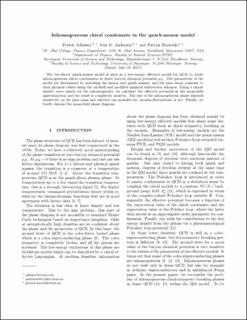| dc.contributor.author | Adhikari, Prabal | |
| dc.contributor.author | Andersen, Jens Oluf | |
| dc.contributor.author | Kneschke, Patrick | |
| dc.date.accessioned | 2023-01-12T09:54:44Z | |
| dc.date.available | 2023-01-12T09:54:44Z | |
| dc.date.created | 2017-07-24T20:26:07Z | |
| dc.date.issued | 2017 | |
| dc.identifier.citation | Adhikari, P., Andersen, J. O., & Kneschke, P. (2017). Inhomogeneous chiral condensate in the quark-meson model. Physical Review D, 96(1), 016013. | en_US |
| dc.identifier.issn | 1550-7998 | |
| dc.identifier.uri | https://hdl.handle.net/11250/3042927 | |
| dc.description.abstract | The two-flavor quark-meson model is used as a low-energy effective model for QCD to study inhomogeneous chiral condensates at finite baryon chemical potential μ B. The parameters of the model are determined by matching the meson and quark masses, and the pion decay constant to their physical values using the on-shell and modified minimal subtraction schemes. Using a chiral-density wave ansatz for the inhomogeneity, we calculate the effective potential in the mean-field approximation and the result is completely analytic. The size of the inhomogeneous phase depends sensitively on the pion mass and whether one includes the vacuum fluctuations or not. Finally, we briefly discuss the mean-field phase diagram. | en_US |
| dc.language.iso | eng | en_US |
| dc.publisher | American Physical Society | en_US |
| dc.title | Inhomogeneous chiral condensate in the quark-meson model | en_US |
| dc.type | Journal article | en_US |
| dc.description.version | acceptedVersion | en_US |
| dc.rights.holder | The authors | en_US |
| dc.subject.nsi | VDP::Matematikk og Naturvitenskap: 400 | en_US |
| dc.source.volume | 96 | en_US |
| dc.source.journal | Physical Review D | en_US |
| dc.source.issue | 1 | en_US |
| dc.identifier.doi | 10.1103/PhysRevD.96.016013 | |
| dc.identifier.cristin | 1482999 | |
| cristin.unitcode | 217,8,2,0 | |
| cristin.unitname | Institutt for matematikk og naturvitenskap | |
| cristin.ispublished | true | |
| cristin.fulltext | postprint | |
| cristin.qualitycode | 0 | |
